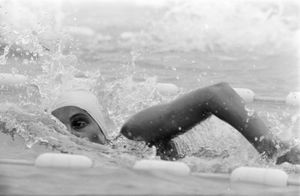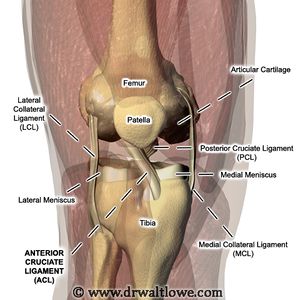Swimming Overuse Injuries
This article or area is currently under construction and may only be partially complete. Please come back soon to see the finished work! (13/09/2019)
Original Editor - Your name will be added here if you created the original content for this page.
Top Contributors - Lucinda hampton, Kim Jackson, Wanda van Niekerk, Jacob Bischoff and Mohit Chand
Introduction[edit | edit source]
Swimming is a great sport enjoyed by all age groups at all levels of ability. It is a unique sport that in that it combines upper and lower extremity strength exercises with cardiovascular training in a nonweightbearing environment. Swimmers are unfortunately prone to injuries. Most swimming injuries are classed as overuse injuries and relate to faulty biomechanics The most common swimming injury regions are the shoulder, neck, lower back, and knee.
Swimming overuse injuries usually arise from one or a combination of the below
- Poor stroke mechanics
- Poor breathing technique
- Poor flexibility or range of motion eg of neck or low back
- Hyper flexibility of joints with insufficient muscular stabilisation
- Decreased rotator cuff or scapular muscle strength
- Insufficient core strength/stability
- Decreased hip muscle strength
- Overtraining
- Not enough rest periods
A 2012 study into epidemiology of swimming injuries highlighting that "An understanding of swimming biomechanics and typical injuries in swimming aids in early recognition of injury, initiation of treatment, and design of optimal prevention and rehabilitation strategies"[1]
Swimmers Shoulder[edit | edit source]
Shoulder pain is the most frequent orthopaedic injury in swimmers, with a reported prevalence between 40% and 91% in elite swimmers[1] Swimmer's shoulder is a condition with a gradual onset due to repetitive activity and can be classified as microtrauma. Swimmer's shoulder usually presents as subacromial impingement involving the rotator cuff tendon, bicipital tendon, or subacromial bursa.[3]
Primary subacromial impingement involves compression of these structures between the acromion and greater tuberosity (due to usually a tight posterior capsule causing the humeral head to migrate anteriorly) or abnormal acromial morphology. However, primary impingement syndrome is less common in competitive swimmers than secondary impingement.[3]
Secondary impingement occurs through a series of impairments, usually in a swimmer with increased anterior glenohumeral laxity ( Shoulder ROM in swimmers often exhibit excessive external rotation and limited internal rotation). This shift in ROM towards increased external rotation is an adjustment to the demands on the glenohumeral joint allowing anterior laxity and greater demand on the rotator cuff and the long head of the biceps to reduce humeral head elevation and anterior translation.[3]
Chronic swimmer's shoulder can result in pathology of the rotator cuff, glenoid labrum, and long head of the biceps.
Subjective examination[edit | edit source]
Should provide information about the area, symptom description, and behavior of the symptoms in patients with swimmer's shoulder. Questions to ask include [3]
- site of pain ( easy to localise or broad region) and or neurological sensations
- irritability of condition (pain level, time to provoke, latency of pain)
- current training program, recent changes, changes in stroke technique
- has swimmer had stroke assessment /correction sessions
Objective examination[edit | edit source]
Include[3]
- postural impairments of the shoulder girdle eg increased thoracic kyphosis, decreased cervical lordosis, protracted scapulae, and internally rotated/anterior humeral head.
- strength of scapular stabilisers, rotator cuff muscles, latisumus dorsi, trapezius
- length of shoulder girle muscles and soft tissues ( noting laxity or restrictions)
- AROM shoulder looking for eg painful arc, excessive laxity, altered scapulohumeral rhythm
- PROM tests, including Sulcus sign, relocation test, apprehension sign
- see also Subacromial Impingement Cluster,
Physiotherapy[edit | edit source]
Swimmers shoulder is a condition that may be prevented with adequate screening that can identify impairments and training errors that may lead to symptoms. If a swimmer presents with symptoms identify the most likely impairments or training errors and rule out any significant tissue pathology. A comprehensive rehabilitation program should be instituted that includes strengthening of the rotator cuff and scapular stabilizers, stretching anterior chest musculature that may be shortened, and modifying if necessary the training regime[3]. If improper swimming technique was implicated ensure stroke correction training takes place.
For specific physiotherapy recommendations regarding treatment see relevant section in Rotator Cuff Tendinopathy
Swimmers Neck[edit | edit source]
Neck pain is mainly seen in the older athlete It may be due to facet joint arthritic change, and disc degeneration +/- nerve root irritation. Muscle innervation and sensation to the shoulder region is predominantly derived from the C5/C6 nerve roots. If these nerve root are irritated due to degenerative change in the neck, shoulder complaints can arise. Arthritic change may limit neck rotation making correct breathing patterns difficult. Swimmers who unilaterally breath are more prone to neck pain. Looking forward rather than directly downward, and extending the head too high when taking a breath increases the load on the neck and create pain.
Swimmers Back[edit | edit source]
The spine is also a recognized site predisposed to injury in the elite swimmer, mainly associated with butterfly swimmers ( 33.3%-58%) and breaststroke swimmers (22.2%- 47%), figures varying from differing studies.
As swimming athletes are positioned horizontally in the water, gravity and buoyancy forces are traveling through the body with the potential to cause changes at the lumbar spine. Due to the undulating motion (lumbar extension) utilised in butterfly and breaststroke, there is potential for developing pain secondary to stress on the joints[4].
Causes include
- Hyperextension of the lumbar spine during freestyle and butterfly
- poor kick technique
- stress fractures are a potential cause in young swimmers
- disc degeneration and facet joint degeneration in the older swimmer
- improper timing of this butterfly stroke increases strain on low back the possibility of neck, shoulder, or back pain.
- poor flexibility of the spine and low back
- insufficient core strength to maintain straight alignment of body in water
- tightness in the hip flexors or inadequate body roll during swimming may lead to compensation at the lumbar spine.
Swimmers Knee[edit | edit source]
Knee pain figures range from 34% to 86% for a single knee episode, being highest in breaststokers,[1]
Knee pain is caused mainly during breaststroke swimming. Repetitive stress placed is placed on the medial knee produces pain during the whip-like motion. The breaststroke kick is a high valgus load produced during sudden flexion-extension, adduction and external rotation of the knee against the hydrodynamic environment, resulting in stress to the medial compartment. Hence a strain occurs to the medial collateral ligament and compression on the lateral knee (possibly causing: sprain on the MCL; irritation of the medial plica; bursal irritation at the muscular insertions of the adductor and hamstring muscles). Strain injuries may also present in the adductor muscles (adductor magnus and brevis, especially)[5]
Resources[edit | edit source]
- bulleted list
- x
or
- numbered list
- x
References[edit | edit source]
- ↑ 1.0 1.1 1.2 Wanivenhaus F, Fox AJ, Chaudhury S, Rodeo SA. Epidemiology of injuries and prevention strategies in competitive swimmers. Sports health. 2012 May;4(3):246-51. Available from: https://www.ncbi.nlm.nih.gov/pmc/articles/PMC3435931/ (last accessed 11.9.2019)
- ↑ Hospital for special surgery What are common swimming injuries? Available from: https://www.youtube.com/watch?v=FeEbg5rlOX0&app=desktop (last accessed 12.9.2019)
- ↑ 3.0 3.1 3.2 3.3 3.4 3.5 Tovin BJ. Prevention and treatment of swimmer's shoulder. North American journal of sports physical therapy: NAJSPT. 2006 Nov;1(4):166. Available from: https://www.ncbi.nlm.nih.gov/pmc/articles/PMC2953356/ (last accessed 13.9.2019)
- ↑ Wanivenhaus F, Fox AJ, Chaudhury S, Rodeo SA. Epidemiology of injuries and prevention strategies in competitive swimmers. Sports health. 2012 May;4(3):246-51. Available from: https://www.ncbi.nlm.nih.gov/pubmed/23016094 (last accessed 13.9.2019)
- ↑ Rodeo SA. Knee pain in competitive swimming. Clinics in sports medicine. 1999 Apr 1;18(2):379-87. Available from: https://www.ncbi.nlm.nih.gov/pubmed/10230572 (last accessed 13.9.2019)








